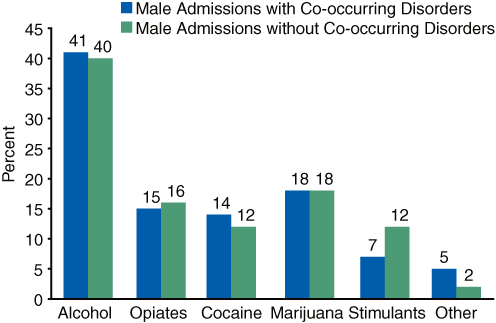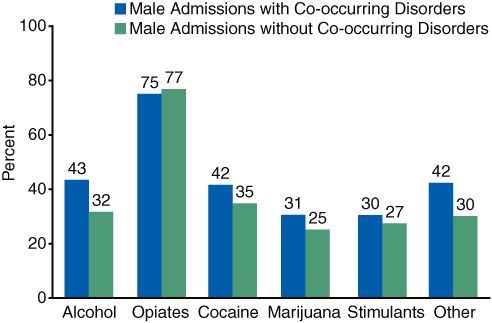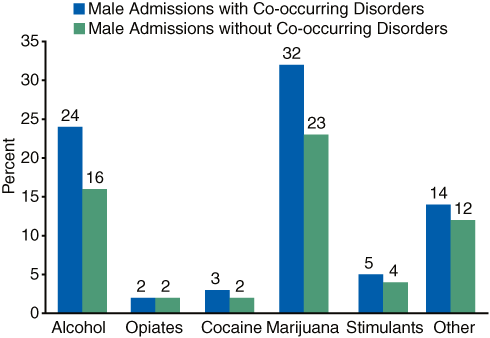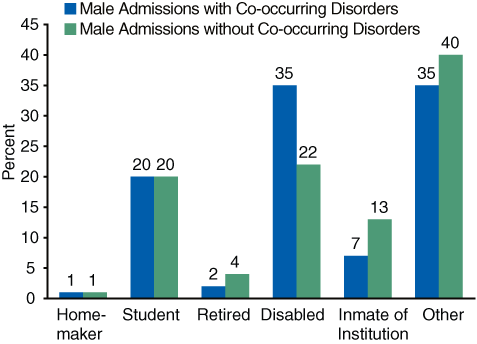
 |
December 13, 2007 |
|
Many individuals who have a substance use problem also have a co-occurring psychiatric disorder.1,2 Previous research has shown that people with both a substance use disorder and a co-occurring psychiatric disorder were more likely to use multiple drugs and to have more economic and social problems than those without a co-occurring psychiatric disorder.3,4,5 There is also evidence that there are differences between males and females in both the incidence and outcomes of co-occurring mental health and substance use disorders.6 National Survey on Drug Use and Health (NSDUH) data show that in 2006 there were an estimated 2.7 million males aged 18 or older with both a psychiatric disorder and a substance use disorder.2 This report will focus on males, who accounted for 55 percent of all substance abuse treatment admissions with co-occurring psychiatric and substance use disorders in 2005. The substance abuse treatment admissions of males with a co-occurring psychiatric disorder can be monitored with the Treatment Episode Data Set (TEDS), which is an annual compilation of data on the demographic characteristics and substance abuse problems of those admitted to substance abuse treatment, primarily at facilities that receive some public funding.7 TEDS records represent admissions rather than individuals, as a person may be admitted to treatment more than once during a single year. TEDS includes a Minimum Data Set collected by all States and a Supplemental Data Set collected by some States. Psychiatric problem in addition to alcohol or drug problem is a Supplemental Data Set item.8 Only data on admissions for the 26 States with a response rate of 75 percent or higher on this item in 2005 were used in the remainder of this report.
Of the approximately 544,800 male admissions in these 26 States in 2005, 16 percent (86,500) were admissions with co-occurring substance use and psychiatric disorders (hereafter referred to as co-occurring disorders). This report compares the characteristics of male admissions with co-occurring disorders and male admissions without co-occurring disorders.
Male admissions with and without co-occurring disorders were similar in the proportions reporting individual primary substances of abuse, except for stimulants.9,10 Seven percent of male admissions
with co-occurring disorders reported stimulants as the primary substance of abuse, but 12 percent of those without co-occurring disorders did so (Figure 1).
These two groups differ, however, in how often they used most of these substances. Among male admissions reporting alcohol, cocaine, marijuana, or stimulants as the primary substance of abuse, those with co-occurring disorders were more likely than those without co-occurring disorders to report daily use of these substances (Figure 2).
In addition to reporting a higher frequency of daily use, male admissions with co-occurring
disorders were more likely than those without co-occurring disorders to report having abused multiple substances.11 Specifically, 62 percent of male admissions with co-occurring disorders reported more than one substance of abuse compared with 52 percent of male admissions without co-occurring
disorders.
 |
Source: 2005 SAMHSA Treatment Episode Data Set (TEDS). |
| Primary Substance | Male Admissions with Co-occurring Disorders | Male Admissions without Co-occurring Disorders |
|---|---|---|
| Alcohol | 41% | 40% |
| Opiates | 15% | 16% |
| Cocaine | 14% | 12% |
| Marijuana | 18% | 18% |
| Stimulants | 7% | 12% |
| Other | 5% | 2% |
Source: 2005 SAMHSA Treatment Episode Data Set (TEDS). |
 |
Source: 2005 SAMHSA Treatment Episode Data Set (TEDS). |
| Primary Substance | Male Admissions with Co-occurring Disorders | Male Admissions without Co-occurring Disorders |
|---|---|---|
| Alcohol | 43% | 32% |
| Opiates | 75% | 77% |
| Cocaine | 42% | 35% |
| Marijuana | 31% | 25% |
| Stimulants | 30% | 27% |
| Other | 42% | 30% |
Source: 2005 SAMHSA Treatment Episode Data Set (TEDS). |
Male admissions with co-occurring disorders were more likely than male admissions without co-occurring disorders to have started using alcohol or drugs before the age of 13 (18 vs. 13 percent),12 with the largest differences for marijuana (32 vs. 23 percent) and alcohol (24 vs. 16 percent) (Figure 3).
 |
Source: 2005 SAMHSA Treatment Episode Data Set (TEDS). |
| Primary Substance | Male Admissions with Co-occurring Disorders | Male Admissions without Co-occurring Disorders |
|---|---|---|
| Alcohol | 24% | 16% |
| Opiates | 2% | 2% |
| Cocaine | 3% | 2% |
| Marijuana | 32% | 23% |
| Stimulants | 5% | 4% |
| Other | 14% | 12% |
Source: 2005 SAMHSA Treatment Episode Data Set (TEDS). |
Male admissions with co-occurring disorders had a distinctly different pattern of prior substance abuse treatment than did their counterparts without co-occurring disorders. Those with co-occurring disorders were more likely than those without co-occurring disorders to report five or more prior substance abuse treatment
episodes (17 vs. 10 percent). Conversely, male admissions with co-occurring disorders were less likely than those without co-occurring disorders to have had no previous substance abuse treatment (39 vs. 47 percent). Males with and without co-occurring disorders were almost equally likely to report one to four prior substance abuse treatment episodes (44 and 43 percent, respectively).
Although male admissions with and without co-occurring disorders had similar levels of unemployment (31 and 33 percent, respectively) and part-time employment (6 and 8 percent, respectively), male admissions with co-occurring disorders were more likely than those without co-occurring disorders to be not in the labor force (44 vs. 31 percent) and were less likely to be employed full time (19 vs. 28 percent).13
Among those whose employment status was not in the labor force, male admissions with co-occurring disorders were more likely than those without co-occurring disorders to be disabled (35 vs. 22 percent) and less likely to be inmates of an institution (7 vs. 13 percent) (Figure 4).
 |
Source: 2005 SAMHSA Treatment Episode Data Set (TEDS). |
| "Not in Labor Force" Status | Male Admissions with Co-occurring Disorders | Male Admissions without Co-occurring Disorders |
|---|---|---|
| Homemaker | 1% | 1% |
| Student | 20% | 20% |
| Retired | 2% | 4% |
| Disabled | 35% | 22% |
| Inmate of Institution | 7% | 13% |
| Other | 35% | 40% |
Source: 2005 SAMHSA Treatment Episode Data Set (TEDS). |
1 Center for Substance Abuse Treatment. (2005). Substance abuse treatment for persons with co-occurring disorders (Treatment Improvement Protocol (TIP) Series 42; DHHS Publication No. (SMA) 05-3922). Rockville, MD: Substance Abuse and Mental Health Services Administration. Retrieved May 23, 2007, from http://www.ncbi.nlm.nih.gov/books/bv.fcgi?rid=hstat5.section.74099
2 National Survey on Drug Use and Health: 2006. Rockville, MD: Substance Abuse and Mental Health Services Administration.
3 Mowbray, C. T., Ribisl, K. M., Solomon, M., Luke, D. A., & Kewson, T. P. (1997). Characteristics of dual diagnosis patients admitted to an urban, public psychiatric hospital: An examination of individual, social, and community domains. American Journal of Drug and Alcohol Abuse, 23(2), 309-326.
4 McDermut, W., Mattia, J., & Zimmerman, M. (2001). Comorbidity burden and its impact on psychosocial morbidity in depressed outpatients. Journal of Affective Disorders, 65(3), 289-295.
5 Compton, M. T., Weiss, P. S., West, J. C., & Kaslow, N. J. (2005). The associations between substance use disorders, schizophrenia-spectrum disorders, and Axis IV psychosocial problems. Social Psychiatry and Psychiatric Epidemiology, 40(12), 939-946.
6 Grella, C. E., & Joshi, V. (1999). Gender differences in drug treatment careers among clients in the national Drug Abuse Treatment Outcome Study. American Journal of Drug and Alcohol Abuse, 25(3), 385-406.
7 In 2005, TEDS collected data on 1.8 million admissions to substance abuse treatment facilities. Four States and jurisdictions (AK, DC, NM, and WY) did not submit data in 2005.
8 Psychiatric problem in addition to alcohol or drug problem is a Supplemental Data Set item. The 26 States and jurisdictions in which it was reported for at least 75 percent of all admissions in 2005—AR, CA, CO, DE, FL, IA, ID, KS, KY, LA, MA, MD, ME, MI, MO, MS, NC, NV, OH, OK, PR, RI, SC, TN, UT, and WV—accounted for 45 percent of all substance abuse treatment admissions in 2005.
9 The primary substance of abuse is the main substance reported at the time of admission.
10 Stimulants include methamphetamine, other amphetamines, and other stimulants such as Benzedrine, Dexedrine, Preludin, Ritalin, and any other amines and related drugs. Methamphetamines accounted for 89 percent of primary stimulant admissions in 2005.
11 TEDS allows the recording of up to three different substances of abuse.
12 Age of first use is defined differently for alcohol than for drugs. For alcohol, age of first use signifies age of first intoxication. For drugs, age of first use identifies the age at which the respective drug was first used.
13 Analysis of employment status is restricted to admissions aged 16 or older. Not in labor force includes those not looking for work during the past 30 days, students, homemakers, disabled or retired persons, or inmates of an institution. Unemployed, by contrast, includes admissions currently seeking work.
Substance Abuse and Mental Health Services Administration, Office of Applied Studies. (December 13, 2007). The DASIS Report: Male Admissions with Co-occurring Psychiatric and Substance Use Disorders: 2005. Rockville, MD.
| The Drug and
Alcohol Services Information System (DASIS) is an integrated data
system maintained by the Office of Applied Studies, Substance Abuse and
Mental Health Services Administration (SAMHSA). One component of DASIS
is the Treatment Episode Data Set (TEDS). TEDS is a compilation of data
on the demographic characteristics and substance abuse problems of
those admitted for substance abuse treatment. The information comes
primarily from facilities that receive some public funding. Information
on treatment admissions is routinely collected by State administrative
systems and then submitted to SAMHSA in a standard format. TEDS records
represent admissions rather than individuals, as a person may be
admitted to treatment more than once. State admission data are reported
to TEDS by the Single State Agencies (SSAs) for substance abuse
treatment. There are significant differences among State data
collection systems. Sources of State variation include completeness of
reporting, facilities reporting TEDS data, clients included, and
treatment resources available. See the annual TEDS reports for details.
Approximately 1.8 million records are included in TEDS each year. The DASIS Report is prepared by the Office of Applied Studies, SAMHSA; Synectics for Management Decisions, Inc., Arlington, Virginia; and by RTI International in Research Triangle Park, North Carolina (RTI International is a trade name of Research Triangle Institute). Information and data for this issue are based on data reported to TEDS through October 3, 2006. Access the latest TEDS reports
at: |
| The DASIS Report is published periodically by the Office of Applied Studies, Substance Abuse and Mental Health Services Administration (SAMHSA). All material appearing in this report is in the public domain and may be reproduced or copied without permission from SAMHSA. Additional copies of this report or other reports from the Office of Applied Studies are available online: http://www.oas.samhsa.gov. Citation of the source is appreciated. For questions about this report please e-mail: shortreports@samhsa.hhs.gov |
|
This page was last updated on December 30, 2008. |
|
SAMHSA, an agency in the Department of Health and Human Services, is the Federal Government's lead agency for improving the quality and availability of substance abuse prevention, addiction treatment, and mental health services in the United States. 
* PDF formatted files require that Adobe Acrobat Reader® program is installed on your computer. Click here to download this FREE software now from Adobe. |